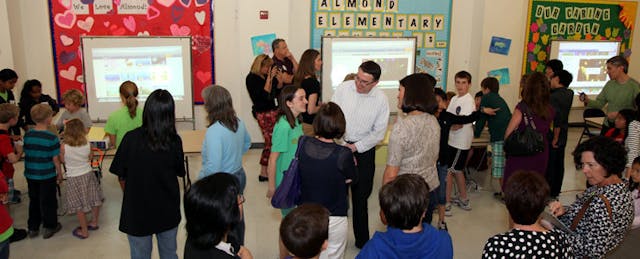Music recitals, science fairs, walkathons and other events fill a school calendar. This year, Los Altos School District (LASD) added another type of school event to its calendar--a coding showcase and competition. On Friday April 26, in the Almond school multipurpose room, tables with laptops connected to projectors showcased code developed by the 500+ sixth graders from the seven schools in the district. Each table was managed by student volunteers from the school. Parents, siblings, teachers, and school administrators buzzed around the room in the glow of the projectors, playing games created by the sixth graders. Projects varied from multi-level math games to trivia games, each showcasing coding skills mastered in class.
LASD is one of the few public school districts in the area that exposes every sixth grader to coding in school. With funding support from parent led Los Altos Educational Foundation (LAEF), a year-long program called CSTEM introduces programming through creative and collaborative projects like creating art through code and building video games.
In addition to demonstrating class assignments at the showcase, the sixth graders had the option to submit an individual or a team project to the coding competition. Instead of the typical high pressure coding contest where students must program solutions in a short amount of time, this competition encouraged students to work in teams over a few weeks and submit a project in one of 3 categories: art, math & science games, or ‘other’ games.
Competitions can be both good and bad. It can either inspire a student to go the extra mile, or just turn them off completely. Some students who were confident programmers chose to not compete while others excited about their new found coding skills, collaborated and decided to go ahead and submit a favorite project.
Over 100 students participated in the competition, a surprising 21% participation rate for a first time event. And--even more surprising--58% of the competition participants were girls! At a time when much is written about the gender gap in computer science, it was good to see that, at least in the LASD 6th grade, the numbers tell a different story.
Most of the sixth graders spent many hours outside of class working on their submissions. Many learned the advantages of collaboration; 55% of the projects were team entries (mostly teams of 2). The final entries to the competition were creative, complex and showed the effort involved. One of the judges, Joel Burget, an engineer who works on the Khan Academy CS platform, said the following about the competition entries:
I was really impressed by entrants in each category ... I spent a lot longer than necessary judging the math and science games because they reminded me of games I used to play in school . The "other" category included some large and very impressive games which went far beyond my expectations.
The girls and boys in LASD’s sixth grade appear to have no fear about coding. In fact, most students think it is challenging, useful and a fun way to spend their time. Their responses to an anonymous survey “What would you tell someone to convince them to learn to code?” were inspiring. Here are some sample responses:
I would tell someone that coding is type of art. There are no bounds to your creativity and you can create anything you want, it can be easy or hard. And the most important thing is to always have fun.
Coding is difficult to understand but, it's really fun once you learn something new and you get to use it.
You should try coding! It's really fun, but I'm not promising that It's easy. Its really useful and it teaches you patience.
I really think coding is useful, and even fun. Coding uses all that I have learned in math, and applies it to the real world. Coding also teaches me that your first work isn't always the best.
Coding is difficult. I think it is boring at first but once you start you don't want to stop. I takes a lot of work and pays off once you finish. You can make fun games.
I LOVE coding. There is so much that you can do with it. It is such a fun experience and you really get a taste of what game-makers go through. It's sometimes frustrating though, because it's not always obvious exactly what you're supposed to do to make the game work like you want.
I enjoy coding because its fun to create computer programs and there are no limits to your creativity. You can make anything you want. And you can always improve on it. There are many types of things you can make. And there are many things coding is useful for. Coding is a fun way to pass time, its something you can do if you are ever bored.
The coding showcase and competition at LASD is a celebration of early computer science education. It highlights the importance of teaching coding in our schools as a required class for everyone. This is not an after school/lunch club/summer camp/elective type of program, catering only to those who believe they should code. Every student learns to code; it gives them a chance to find out what it is all about. As these 6th graders found out, coding can be difficult but fun--what Seymour Papert described so well in his article as ‘hard fun’.


